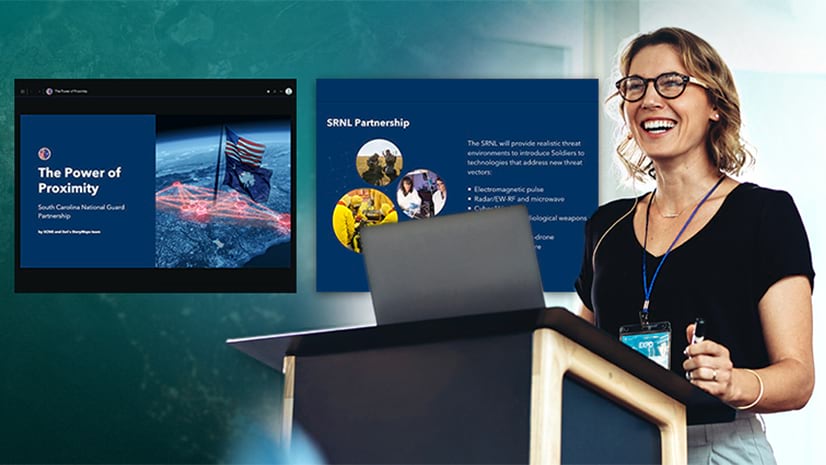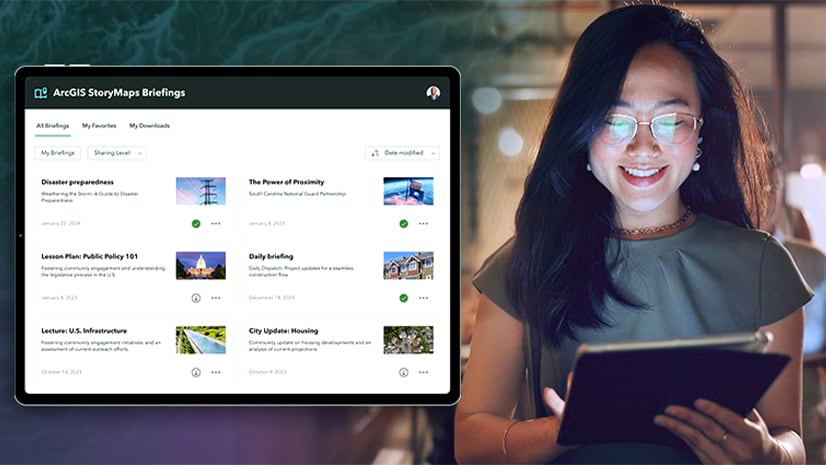ArcGIS StoryMaps celebrates its
200th release this month!
🎉 🎉 🎉
This journey started about 5 years ago (a little longer if you count from the initial beta release) with a dream of creating a next-generation storytelling tool for ArcGIS. Fast-forward to today—200 software releases later—and we remain amazed by all the engaging, gorgeous, informative, and impactful stories being told by the community using ArcGIS StoryMaps.
And of course we haven’t slowed down adding new features and capabilities. Earlier this year marked the introduction of briefings, a slide-based storytelling format, that helps you communicate and tell stories in new ways. This month we’ve added more features to briefings, stories, and collections. Help us celebrate by taking a look back at all the features ArcGIS StoryMaps has added over the years: ArcGIS Blog: What’s new in ArcGIS StoryMaps
Here’s a rundown of what’s new this month:
- Link-style media actions
- Add tables and code to briefings
- Configure analytics for briefings
- Show date for collections
- Hide story cover
- More image formats
- And more…
Link-style media actions
Media actions were recently introduced in ArcGIS StoryMaps. This feature provides the ability to create buttons that readers can click to show different pieces of media in the sidecar. Media actions, along with map actions and map choreography, enable many creative storytelling techniques. Now, in addition to creating media action buttons, you can also configure media actions on text selections in your story. This gives you another option for creating interactive elements that are more compact and appear inline in a story paragraph.
Check out this video to see link-style media actions…in action.
If you want to learn more about media actions, see Supercharge your stories with media actions.
Add tables and code to briefings
The ability to add tables to a story was added back in August 2023, which happened to be the same time briefings were released in beta. These features have now come together and you’re able to add nicely formatted tabular information to your briefings.
It’s extremely useful to be able to summarize statistical data for an audience in a table or provide a status update in an easily digestible form. Check out this video see see how easy it is to create a table.
Additionally, the code block is available in briefings. If you have Python scripts, JavaScript code, CSS snippets, or code in another programming language, you can now paste them into a briefing to share with your audience. The code block is also a great way to share and explain Arcade scripts with your colleagues. You’ll probably want to take advantage of the built-in syntax highlighting, and you can add line numbers if they are helpful. Here’s an example of how to add code and configure the helpful options that are available.
Configure analytics for briefings
You may be familiar with using Google Analytics or Adobe Analytics to track audience engagement with your stories. Now you can use these services to track views and other reader interactions for your published briefings as well.
The process for setting this up for a briefing is similar to how it works for a story. You’ll find a familiar looking Analytics tab in the Briefing settings where you can choose the analytics service you’d like to use and enter your configuration information.
For more detail about tracking audience engagement, see Use web analytics to measure your traffic in ArcGIS StoryMaps (esri.com).
Show date for collections
Showing a date on the cover was something you have been able to do for stories and briefings, and now this is available for collections. Just hop into the Collection settings and select the date display option you’d like and the date will be visible to your readers.
Hide story cover
We’ve heard from some advanced authors who sometimes want to create a story without a cover. While you can already do this in specific situations, like when you add a story to a collection or when you are embedding a story in another website, some people wanted a persistent way to hide the cover for a story. This option is now available in the story settings.
There are a few things to be aware of when activating this option. It is best used in a few specific situations, such as when creating a story for a demonstration you’re delivering or for an unattended kiosk at a museum, exhibit, or conference. Since important information about the story is hidden from viewers when this option is enabled, the story will not be eligible to appear in web search results so you’ll see that option disabled when you publish.
More image formats
ArcGIS StoryMaps already supports five of the most common image file formats (JPG, PNG, GIF, BMP, and SVG), and you can now use more types of images including HEIC, HEIF, TIFF/TIF, and WEBP. These file types can be uploaded directly in the story, briefing, or collection builders without the need to convert them to another format first.
If you missed it, support was also added for more video and audio file types over the last few months. The list of supported video file types now includes MP4, MOV, AVI, WEBM, MKV, and for audio the list is MP3, WAV, OGG, ACC, and M4A for audio.
For more information about supported media file types and sizes, see the FAQ.
And more…
We mentioned this last month, but a new featured theme is available for the upcoming 2024 Esri User Conference. Check it out in the featured theme gallery! Also, the maximum number of rows for a table in a story has been increased to 11, which includes the heading row, so you now have enough rows to create a “top 10” list.
Lastly, be sure to review the release notes for more detail about other small changes and fixes released this month.
Thanks to Will Hackney for his contributions to this post.
Banner image: © 2024 Adobe Stock. All rights reserved.




Article Discussion: